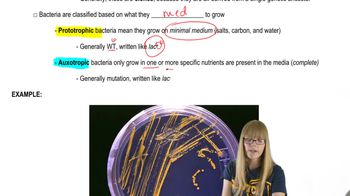Using your knowledge of DNA repair pathways, choose the pathway that would be used to repair the following types of DNA damage. Explain your reasoning.
a double-stranded break that occurs during G₁ and prevents completion of DNA replication
Table of contents
- 1. Introduction to Genetics51m
- 2. Mendel's Laws of Inheritance3h 37m
- 3. Extensions to Mendelian Inheritance2h 41m
- 4. Genetic Mapping and Linkage2h 28m
- 5. Genetics of Bacteria and Viruses1h 21m
- 6. Chromosomal Variation1h 48m
- 7. DNA and Chromosome Structure56m
- 8. DNA Replication1h 10m
- 9. Mitosis and Meiosis1h 34m
- 10. Transcription1h 0m
- 11. Translation58m
- 12. Gene Regulation in Prokaryotes1h 19m
- 13. Gene Regulation in Eukaryotes44m
- 14. Genetic Control of Development44m
- 15. Genomes and Genomics1h 50m
- 16. Transposable Elements47m
- 17. Mutation, Repair, and Recombination1h 6m
- 18. Molecular Genetic Tools19m
- 19. Cancer Genetics29m
- 20. Quantitative Genetics1h 26m
- 21. Population Genetics50m
- 22. Evolutionary Genetics29m
17. Mutation, Repair, and Recombination
Induced Mutations
Problem 40
Textbook Question
Common baker's yeast (Saccharomyces cerevisiae) is normally grown at 37°C, but it will grow actively at temperatures down to approximately 25°C. A haploid culture of wild-type yeast is mutagenized with EMS. Cells from the mutagenized culture are spread on a complete-medium plate and grown at 25°C. Six colonies (1 to 6) are selected from the original complete-medium plate and transferred to two fresh complete-medium plates. The new complete plates (shown) are grown at 25°C and 37°C. Four replica plates are made onto minimal medium or minimal plus adenine from the 25°C complete-medium plate. The new plates are grown at either 25°C or 37°C and the growth results are shown.
Which colonies are prototrophic and which are auxotrophic? What growth information is used to make these determinations? <>
 Verified step by step guidance
Verified step by step guidance1
Understand the definitions: Prototrophic organisms can grow on minimal medium because they can synthesize all necessary compounds from basic nutrients. Auxotrophic organisms require additional nutrients (e.g., adenine) to grow because they have mutations that prevent them from synthesizing certain compounds.
Analyze the growth data: Examine the growth results of the colonies on the minimal medium plates at both 25°C and 37°C. Colonies that grow on minimal medium at both temperatures are prototrophic, as they do not require additional nutrients. Colonies that fail to grow on minimal medium but grow on minimal medium supplemented with adenine are auxotrophic for adenine.
Consider the temperature sensitivity: If a colony grows on complete medium at 25°C but not at 37°C, it may have a temperature-sensitive mutation. This information helps identify whether the growth defect is related to temperature or nutrient requirements.
Correlate the growth patterns: Use the growth results on minimal medium, minimal plus adenine, and complete medium at both temperatures to classify each colony. For example, if a colony grows on minimal plus adenine but not on minimal medium, it is auxotrophic for adenine. If it grows on minimal medium at both temperatures, it is prototrophic.
Summarize the findings: Based on the growth data, classify each colony (1 to 6) as either prototrophic or auxotrophic. Clearly state which colonies are auxotrophic for adenine and which are prototrophic, and explain how the growth data supports these conclusions.
 Verified video answer for a similar problem:
Verified video answer for a similar problem:This video solution was recommended by our tutors as helpful for the problem above
Video duration:
2mPlay a video:
Was this helpful?
Key Concepts
Here are the essential concepts you must grasp in order to answer the question correctly.
Prototrophy and Auxotrophy
Prototrophy refers to the ability of an organism to synthesize all essential compounds needed for growth from basic nutrients, while auxotrophy indicates a mutation that prevents the organism from synthesizing a specific compound, requiring it to be supplied in the growth medium. In yeast, prototrophic strains can grow on minimal media, whereas auxotrophic strains need additional nutrients, such as adenine, to thrive.
Recommended video:
Guided course

Bacteria in the Laboratory
Mutagenesis
Mutagenesis is the process of inducing mutations in an organism's DNA, often using chemical agents like ethyl methanesulfonate (EMS). This technique is commonly used in genetics to create variations in traits, allowing researchers to study gene function and identify mutations that affect growth and metabolism, such as those leading to prototrophy or auxotrophy.
Recommended video:
Guided course

Induced Mutations
Temperature Effects on Yeast Growth
Temperature significantly influences yeast growth and metabolic activity. Saccharomyces cerevisiae typically grows well at 37°C but can also grow at lower temperatures, such as 25°C. Understanding how temperature affects growth is crucial for interpreting experimental results, as it can impact the expression of mutations and the overall viability of yeast colonies on different media.
Recommended video:
Guided course

Maternal Effect
Related Videos
Related Practice
Textbook Question
337
views


